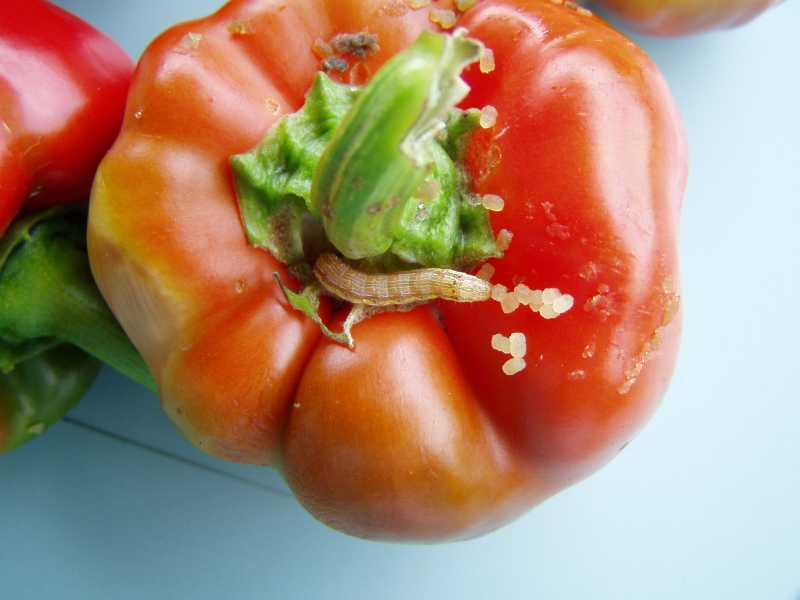Understanding Tomato Fruitworms
Identification
Tomato fruitworms are caterpillars that vary in color from green to brown with distinct stripes along their bodies. They feed on tomato fruits, causing damage to both the exterior and interior of the fruit.
Life Cycle
Understanding the life cycle helps in implementing control measures effectively. Fruitworms go through several stages from egg to larva to pupa, with larvae being the most damaging stage to tomatoes.

Monitoring and Detection
Signs of Infestation
Look for holes in tomato fruits, frass (insect waste), and feeding damage on leaves. Monitoring regularly helps detect early signs of infestation.
Pheromone Traps
Deploy pheromone traps early in the season to monitor adult fruitworm activity. This helps in timing control measures and reducing mating success.
Cultural Control Methods
Crop Rotation
Rotate tomato plants with non-host crops like legumes or grains to disrupt the fruitworm life cycle and reduce pest pressure.
Sanitation
Remove and destroy infested fruits and plant debris promptly to minimize overwintering sites and reduce future infestations.
Biological Control Options
Natural Enemies
Encourage natural predators and parasitoids like Trichogramma wasps and predatory beetles that feed on fruitworm eggs and larvae.
Bt (Bacillus thuringiensis)
Apply Bt-based insecticides targeting fruitworm larvae. Bt is effective and safe for beneficial insects when used according to label instructions.
Chemical Control
Insecticides
Use insecticides as a last resort and choose products labeled for fruitworm control. Rotate chemical classes to prevent resistance buildup and follow safety guidelines.
Integrated Pest Management (IPM)
Implement IPM strategies combining cultural, biological, and chemical control methods tailored to your specific growing conditions and pest pressures.
Expert Advice and Resources
Governmental and Horticultural Bodies
Consult resources from organizations such as the USDA (United States Department of Agriculture) or Extension Services for guidelines on tomato fruitworm control strategies.
Academic Experts
Refer to studies and publications by academic experts in entomology and pest management for detailed insights into fruitworm behavior and control options.
Conclusion
Controlling tomato fruitworms requires vigilance, proactive monitoring, and integrated pest management strategies. By understanding their life cycle and implementing appropriate control measures, gardeners can effectively protect tomato crops from damage and maximize yields.
What is a tomato fruitworm, and what damage does it cause?
The tomato fruitworm (Helicoverpa zea) is a caterpillar that feeds on tomato fruits, causing damage to the exterior and interior, leading to reduced yields and fruit quality.
How can I identify tomato fruitworm infestation in my garden?
Look for holes in tomato fruits, presence of frass (insect waste), and feeding damage on leaves, which are common signs of tomato fruitworm infestation.
What is the life cycle of a tomato fruitworm?
Tomato fruitworms go through egg, larval, pupal, and adult stages. Understanding their life cycle helps in timing control measures effectively.
What are effective cultural methods to control tomato fruitworms?
Cultural methods include crop rotation with non-host plants, sanitation by removing infested fruits and debris, and using pheromone traps to monitor adult activity.
How do natural enemies help control tomato fruitworms?
Natural enemies like Trichogramma wasps and predatory beetles prey on fruitworm eggs and larvae, reducing pest populations naturally.
What is Bt (Bacillus thuringiensis), and how does it control tomato fruitworms?
Bt is a biological insecticide effective against fruitworm larvae. It works by disrupting their digestive system when ingested, providing targeted pest control.
When should I use insecticides to control tomato fruitworms?
Insecticides should be used as a last resort, preferably targeting early larval stages. Rotate chemical classes to prevent resistance and follow safety guidelines.
What are integrated pest management (IPM) strategies for tomato fruitworm control?
IPM combines cultural, biological, and chemical control methods tailored to your garden’s specific conditions, emphasizing sustainable pest management practices.
Are there organic methods to control tomato fruitworms?
Yes, organic methods include using beneficial insects, such as parasitic wasps, and applying organic insecticides approved for use in organic gardening.
How can I prevent tomato fruitworm infestations in future seasons?
Prevent future infestations by practicing crop rotation, maintaining garden hygiene, monitoring regularly with pheromone traps, and selecting pest-resistant tomato varieties.
- Rhode Island’s Favorite THC Infused Beverages - June 5, 2025
- THC Soda and Drink Options in Idaho - May 28, 2025
- Ohio’s Go-To THC Infused Beverages - May 28, 2025




